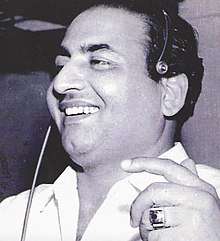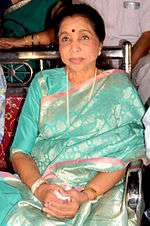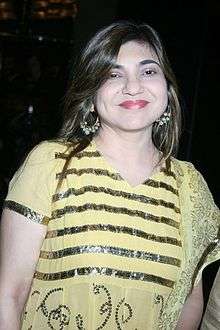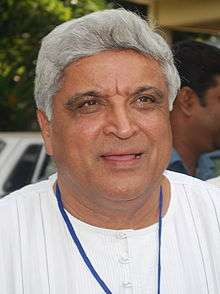Filmfare Awards
The Filmfare Awards are a set of awards that honour artistic and technical excellence in the Hindi-language film industry of India. The Filmfare ceremony is one of the most famous film events in India.[1][2][3] The awards were first introduced by the Filmfare magazine of The Times Group in 1954, the same year as the National Film Awards. They were initially referred to as the "Clare Awards" or "The Clares" after Clare Mendonca, the editor of The Times of India. A dual voting system was developed in 1956. Under this system, in contrast to the National Film Awards, which are decided by a panel appointed by Indian Government, the Filmfare Awards are voted on by both the public and a committee of experts.
| Filmfare Awards | |
|---|---|
 Trophy of the award | |
| Awarded for | Excellence in cinematic achievements |
| Country | India |
| Presented by | Filmfare |
| First awarded | 21 March 1954 |
| Last awarded | 15 February 2020 |
| Website | Filmfare |
| Television/radio coverage | |
| Network | Sony Entertainment Television (India) (2000-2017) Colors TV (2018-Present) |
The ceremony had been sponsored by various private organisations in the past as well as in present provisions. During several years in the 1990s, a live ceremony was broadcast to television audiences but was later discontinued due to unknown reasons. Since 2000, a recorded and edited version of the awards ceremony was televised on SET a week or two after the ceremony has been held. Since 2018, the ceremony has been televised on Colors. The 65th Filmfare Awards event was held on the 16th of February 2020 at Sarusajai Stadium, Guwahati.[4]
The Filmfare Awards have been often referred to as the Hindi film industry's equivalent to the Academy Awards in the United States. Until the mid-1990s, Filmfare Awards were the preeminent and most-recognised awards in Bollywood until several other awards sprouted up in Mumbai. This has resulted in poor viewership since 2000s.[1][2][3][5]
In addition to the flagship event, Filmfare also has variants for other Indian film industries, such as Filmfare Awards South for South Indian cinema, Filmfare Marathi Awards for Marathi cinema, and Filmfare Awards East for eastern Indian cinema.[6]
History
The Introduction
The Filmfare awards were first introduced in 1954. The Clares was the original name of the award ceremony, named after The Times of India critic Clare Mendonca. Readers of Filmfare were polled to decide the winners, and over 20,000 readers spread throughout India participated in the polls; trophies were given to winners of the popular vote. In the first awards function, held on 21 March 1954 at the Metro Theatre of Mumbai, only five awards were presented: Best Film, Best Director, Best Actor, Best Actress, and Best Music Director. Do Bigha Zameen was the first movie to win the award for Best Film. The first winners for other four categories were: Bimal Roy for his direction of Do Bigha Zameen, Dilip Kumar for his performance in Daag, Meena Kumari for her performance in Baiju Bawra, and Naushad Ali for his music in Baiju Bawra. Filmfare Awards also introduced the Short Film Category in 2017, with Vidya Balan and Gauri Shinde on the jury.[7] The People's Choice Award for Best Short Film was presented to Khamakha. Short films like Chutney, Matitali Kusti and Taandav won awards as well.[8]
Hollywood star Gregory Peck was invited to be the guest of honour at the first ever awards on 21 March 1954 at the Metro theatre, Mumbai but could not make it to the function since his flight from Colombo got delayed. However, Peck did attend the banquet that followed the award night at Wellington Club (Gymkhana), Mumbai.[9][10][10]
Postponement in 1986 and 1987
The winners for the year 1985 were announced in 1986 and the event was scheduled to be held at the Brabourne Stadium in December 1986. Unfortunately, the 'Bombay film Industry', as was known then went on strike in '86 because of its many contentious issues with the Government of Maharashtra. So the ceremony was pushed to the next year. The winners of 1985 were awarded on 28 January 1987. Due to Security reasons, Filmfare was not awarded for 1986 and 1987.[11]
Filmfare Statuette
The statuette, depicting a woman whose arms are upraised in a dance number with her fingers touching, is commonly referred to as "The Black Lady" (or "The Lady in Black"). Originally designed by N.G. Pansare under the supervision of Times of India's art director Walter Langhammer, it is generally made of bronze, its height is 46.5 cm and it weighs around five kg.[12] To celebrate the 25th year of the awards, the statues were made in silver and to celebrate the 50th year the statues were made in gold.[13] The Filmfare trophy is manufactured by The Award Gallery since 2000.[14] Till 2012, there were only a few changes made to the trophy. But recently, as of 2013, a huge change has been made to give the trophy a 3-D look.[15] There were two reasons were given for this change. The organisers believe that this was necessary to match the many advances in technology in today's world which will advance a lot more in the coming years as well. Also, this was an attempt to match the theme of the 2013 set of awards at Filmfare in Mumbai: a hundred years leap into the future.[16]
The Red Carpet
The Red Carpet is a segment that takes place before the beginning of the actual ceremony. This is when actors, actresses, producers, directors, singers, composers, and others that have contributed to Indian cinema are introduced.[17] Hosts question the celebrities about upcoming performances and who they think deserves to take the Black Lady home.[18]
In 2013
The 2013 Filmfare awards took place in Mumbai at the Yash Raj Studios in Andheri. A special press conference was held just for its announcement and this took place at the Suburban hotel in Mumbai as well. The theme that year was a hundred years in the future. The reason for the theme to be held that year was because it was meant to be a continuous from previous year's theme where the fraternity celebrated the completion of a hundred years in Indian cinema at the box office.[16]
Awards
Merit awards
- Best Film
- Best Director
- Best Actor
- Best Actress
- Best Supporting Actor
- Best Supporting Actress
- Best Performance in a Negative Role (1992-2007)
- Best Performance in a Comic Role (1967-2007)
- Best Male Debut
- Best Female Debut
- Best Debut Director
- Best Music Direction
- Best Lyricist
- Best Male Playback Singer
- Best Female Playback Singer
Critics' awards
Technical awards
- Best Story
- Best Screenplay
- Best Dialogue
- Best Action
- Best Art Direction
- Best Background Score
- Best Cinematography
- Best Editing
- Best Choreography
- Best Sound Design
- Best Special Effects
- Best Costume Design
Special awards
- Lifetime Achievement
- RD Burman Award for New Music Talent
- Special Performance Award
- Best Scene of the Year (1998-2012)
- Power Award (2003-2007)
Short film awards
- People's choice award for Best Short Film
- Best Short Film in Fiction
- Best Short Film in Non-Fiction
- Best Actor Male Short Film
- Best Actor Female Short Films
Records
Artists with all nominations in a single category
.jpg) Meena Kumari
Meena Kumari
(1963) Mohammed Rafi
Mohammed Rafi
(1969) Asha Bhosle
Asha Bhosle
(1973).jpg) Kishore Kumar
Kishore Kumar
(1985) Alka Yagnik
Alka Yagnik
(1994) Javed Akhtar
Javed Akhtar
(2005)
Most awards for a single film
Most nominations for a single film
|
Most awards won by a male
|
Most awards won by a female
|
Most awards for Best Director
Most awards for Best Choreography
Most consecutive wins in a single category
See alsoReferences
External links
|